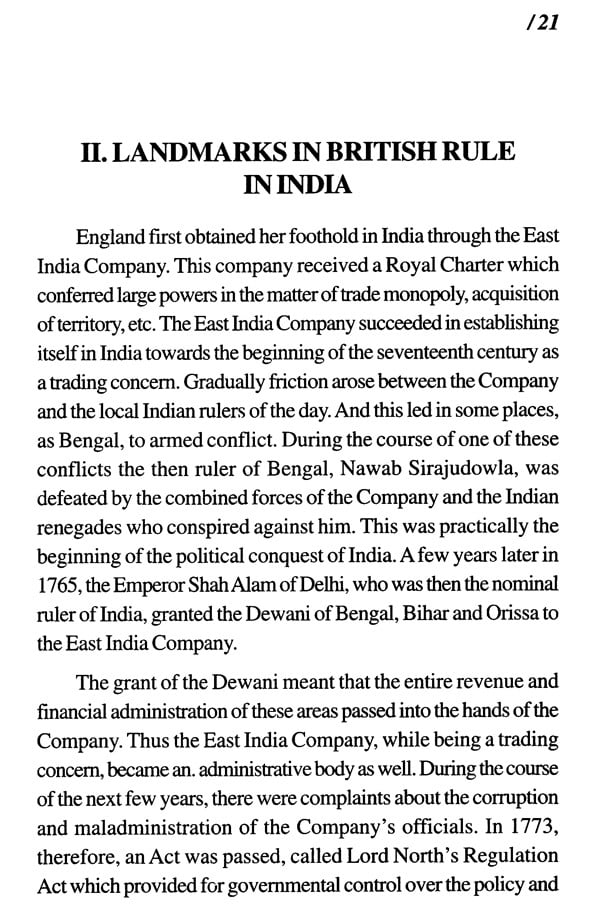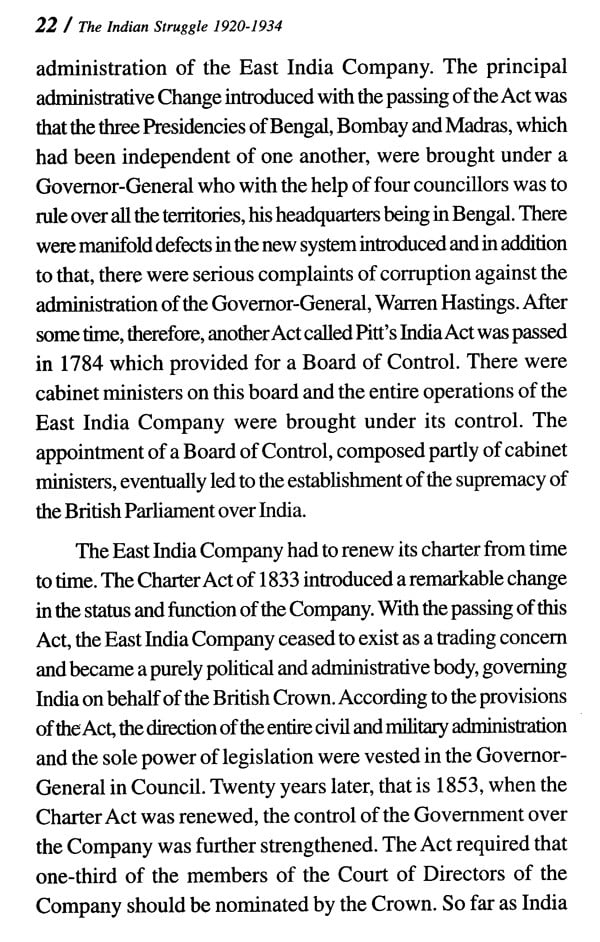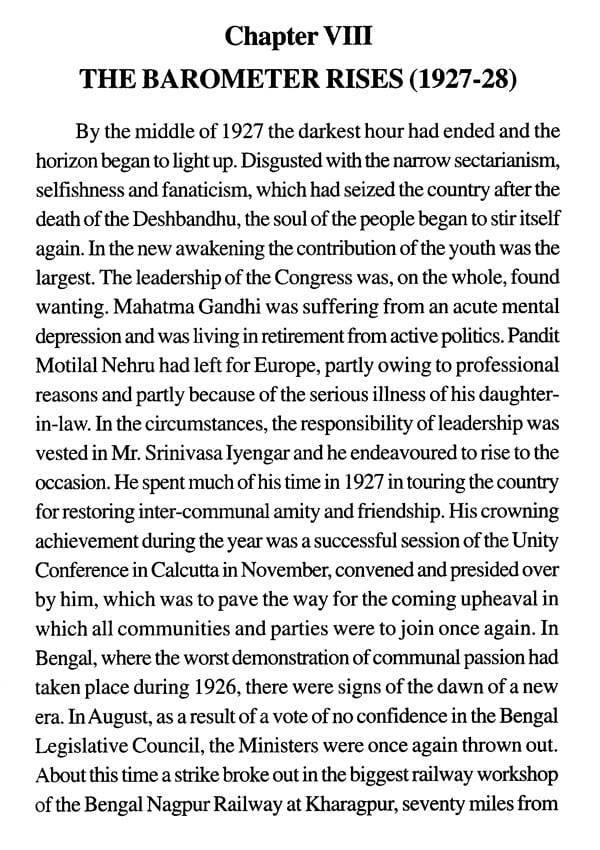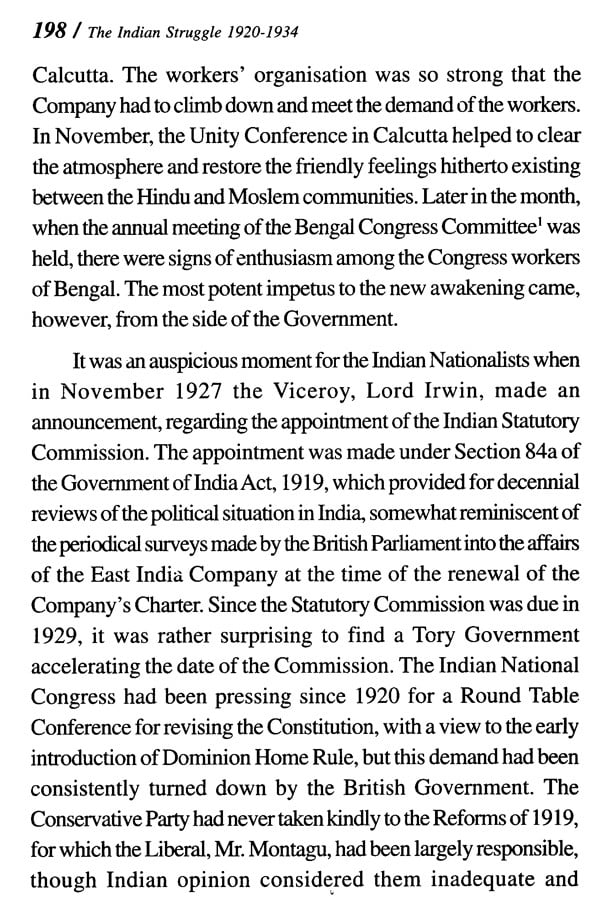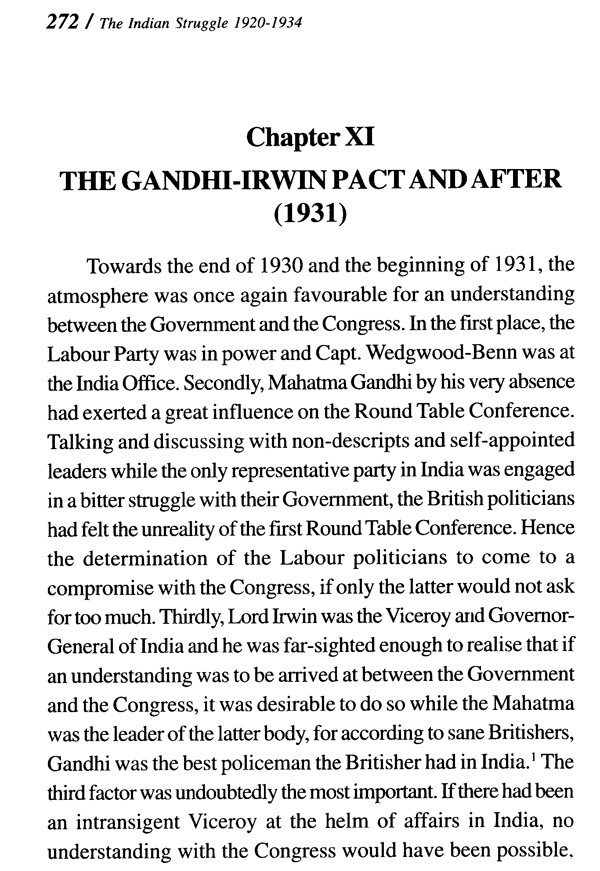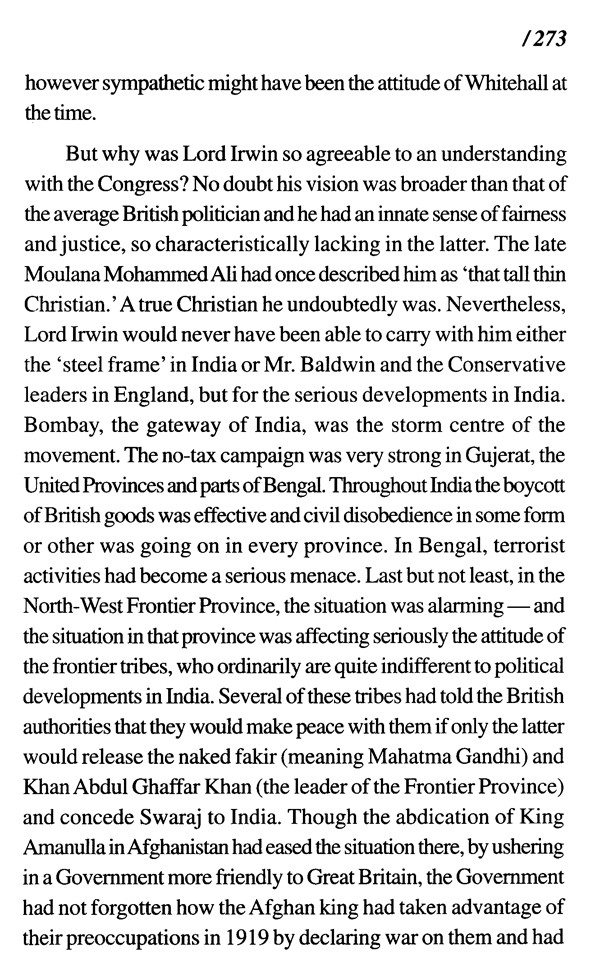
The Indian Struggle (1920-1934) by Subhas Chandra Bose
Book Specification
| Item Code: | NAF869 |
| Author: | S. Chandra Bose |
| Publisher: | Oxford University Press, New Delhi |
| Language: | English |
| Edition: | 2022 |
| ISBN: | 9788182478244 |
| Pages: | 430 |
| Cover: | HARDCOVER |
| Other Details | 8.5 inch X 5.5 inch |
| Weight | 430 gm |
Book Description
About the Book
The Indian Struggle 1920-42 is Netaji Subhas Chandra Bose's major political study of the movement for independence in which he himself was a leading participant. The book provides a lucid, analytical narrative of the freedom struggle from the gathering clouds of the Non-Co-operation and Khilafat movements to the unleashing of the mighty storm of the Quit India and Azad Hind movements. The story of the political upheavals of the inter-war period is enriched by Netaji's reflections on the key themes in Indian history and a finely etched assessment of Mahatma Gandhi's role in it.
Bose wrote the first part of his narrative, 1920-34, as an exile in Europe and the second part, 1935-42, also in Europe eight years later. When the first part was published in 1935 it was immediately banned by the British government. The book was, however, warmly welcomed in literary and political circles in Europe. The Manchester Guardian described it as 'perhaps the most interesting book which has yet been written by an Indian politician on Indian politics. ' Romain Rolland hailed it as an 'indispensable work for the history of the Indian movement.
Editors' Introduction
Sisir K. Bose and Sugata Bose
The Indian Struggle, 1920-1942 is Netaji Subhas Chandra Bose's major political study of the movement for independence in which he himself was a leading participant. The book provides a lucid, analytical narrative of the freedom struggle from the gathering clouds of the non-cooperation and Khilafat movements to the unleashing of the mighty storm of the Quit India and Azad Hind movements. The story of the political upheavals of the inter-war period is enriched by Netaji's reflections on the key themes in Indian history and a finely etched assessment of Mahatma Gandhi's role in it.
Bose wrote the first part of the narrative, 1920-1934, as an exile in Europe. He wrote it in about a year at a time when he was seriously ailing. Moreover, as he himself mentioned in his original preface, while writing what was essentially an historical narrative he had to draw largely from memory in the absence of adequate reference materials at his disposal in Vienna. The book was published by Lawrence and Wishart in London on 17 January 1935. It was particularly well-reviewed in the British press and warmly welcomed in European literary and political circles. The British Government in India, however, with the approval of the Secretary of State for India in London, lost no time in issuing a notification banning its entry into India. Samuel Hoare, the Secretary of State for India, alleged in the House of Commons that the action had been taken because the book tended generally to encourage methods of terrorism and direct action.
As the book did not reach the Indian reading public for well over a decade after its first publication, we can only guess the nature of reaction and response it might have 'evoked. It is interesting, however, to recall how it was received in Britain and the continent of Europe. Reviewing the book The Manchester Guardian gave the following assessment: This is perhaps the most interesting book which has yet been written by an Indian politician on Indian politics. His history of the last fourteen years, though written avowedly from the standpoint of the Left-Wing, is as nearly fair to all parties and everyone as can reasonably be expected of an active politician. He is interested in trade union movements, the peasants' revolt, and the growth of Socialism. Altogether the book leaves us with a wish to see Mr. Bose take a lead in Indian politics.
The Sunday Times found The Indian Struggle 'a valuable book for the enlightenment of opinion. It has a point of view difficult for the British mind to comprehend but it accurately describes a side of the Indian movement that cannot be ignored.' The diplomatic correspondent of The Daily Herald described it as 'calm, sane, dispassionate' and 'the ablest work I have read on current Indian politics. This is the book of no fanatic, but of a singularly able mind, the book of an acute, thoughtful, constructive mind, of a man who while still under forty, would be an asset and an ornament to the political life of any country.' The Spectator found the book 'valuable as a document of con- temporary history'. The reviewer in The News Chronicle described Bose as 'unusually clear-headed for a revolutionary' and added:
His picture of Gandhi is very interesting as an Indian view. It is firmly and convincingly drawn. He does full justice to the marvelous qualities of the saint without condoning in the least the 'Himalayan blunders' of the politician. Bose had corresponded with Rabindra Nath Tagore while he was writing the book and had sought introductions from the poet to British intellectuals like Bertrand Russel and H.G. Wells. At one time he had evidently wished one such person to write a foreword to his book. Later, he either gave up the idea or the plan did not materialise. Nevertheless, from con- temporary press reports it is clear that there was a stir among left-wing British politicians and intellectuals after the banning of the book in India. George Lansbury sent a message to Bose thanking him for the book from which he was 'learning a great deal'.
From Europe the most interesting commentary on the book came from the French savant Romain Rolland who, in the course of a letter to Netaji dated 22 February 1935, wrote: .80 interesting seemed the book to us that I ordered another copy so that my wife and sister should have one each. It is an indispensable work for the history of the Indian Movement. In it you show the best qualities of the historian: lucidity and high equity of mind. Rarely it happens that a man of action as you are is apt to judge without party spirit. Without sharing all your appreciations I find most of them well-founded and they all make us reconsider things with profit. What you say about the dualism in the part played by Gandhi and in his nature made a deep impression on me. Evidently this very dualism makes his personality so original. I am admiring your firm political sense. What a pity that all the ablest leaders of the Indian Social Movement are either imprisoned or exiled as you and Jawaharlal Nehru.
President de Valera of Ireland read the book with great interest and concluded his message by saying: 'I hope that in the near future freedom and happiness will come to the Indian people.' In Rome Bose personally presented a copy to Mussolini who in turn expressed sympathy for the Indian cause. There were reports that publishers there immediately became interested in an Italian edition. An Italian translation was eventually issued in 1942 under the auspices of the Italian Institute of Middle and Far Eastern Affairs. Japanese editions of the first part of the book were published on the eve of World War II and again during the war. It is known that a German edition was planned and was in preparation during Netaji's last sojourn in Europe but it never saw light of day.
The second part of the narrative, 1935-1942, was also written in Europe, eight years after the first part had been completed. Netaji left the manuscript with his wife Emilie Schenkl in Vienna who made it available after the end of the war. A reprint of the 1935 London publication was issued for the first time in India in 1948 and the latter part of the narrative, 1935-42, published separately in 1952. Netaji Research Bureau issued the first combined edition in 1964 and subsequently republished it as volume 2 of Netaji's Collected Works in 1981.
This is a carefully re-edited centenary edition. In presenting Netaji's narrative in its entirety minor changes in chapter titles and arrangement have been made in the interest of the reader. The appendix in the original London edition appears in this volume as 'Epilogue 1934' and it precedes instead of following the chapter entitled 'A Glimpse of the Future'. In the appendix we have published the report of an interview with Bose in London in January 1938 which embodies his clarifications with regard to the references to Fascism and Communism in the chapter entitled 'A Glimpse of the Future'.
Netaji's letters, speeches and articles of the period covered in The Indian Struggle, 1920-1942 can be found in volumes 3 to 11 of the Collected Works. This book's narrative ends in August 1942 with the comment: 'A new chapter in the history of India's struggle for freedom had begun.' What was left un- stated was that in that final chapter of the Indian struggle Netaji was setting out to play a decisive role. Soon after he had completed revisions to the second part of his narrative, he embarked on a perilous submarine journey to Southeast Asia where he led the Azad Hind Fauj in the last war of Indian independence.
Contents
| | Editors' Introduction | ix |
| | Introduction | 1-38 |
| Chapter I | The Clouds Gather (1920) | 39-52 |
| Chapter II | The Storm Breaks (1921) | 53-79 |
| Chapter III | The Anti-Climax (1922) | 80-92 |
| Chapter IV | The Swarajist Revolt (1923) | 93-103 |
| Chapter V | Deshabandhu C.R. Das In Power (1924-25) | 104-124 |
| Chapter VI | The Slump (1925-27) | 125-140 |
| Chapter VII | In Burmese Prisons (1925-27) | 141-156 |
| Chapter VIII | The Barometer Rises (1927-28) | 157-175 |
| Chapter IX | Signs of coming Upheaval (1929) | 176-194 |
| Chapter X | Stormy 1930 | 195-218 |
| Chapter XI | The Gandhi-Irwin Pact and After (1931) | 219-240 |
| Chapter XII | Mahatma Gandhi in Europe (1931) | 241-256 |
| Chapter XIII | The Fight Resumed (1932) | 257-287 |
| Chapter XIV | Defeat and Surrender (1933-34) | 288-307 |
| Chapter XV | The white Paper and the Communal Award | 308-326 |
| Chapter XVI | The Role of Mahatma Gandhi in Indian History | 327-333 |
| Chapter XVII | The Bengal Situation | 334-340 |
| Chapter XVIII | Epilogue 1934 | 341-345 |
| Chapter XIX | A Glimpse of the Future | 346-354 |
| Chapter XX | India Since 1857-A Bird's Eye view | 355-360 |
| Chapter XXI | From January, 1935 till September, 1939 | 361-378 |
| Chapter XXII | From September, 1939 till August, 1942 | 379-395 |
| | Appendix | 397-399 |
| | Index | 401 |
| | PLATES | |
| | Netaji Subhas Chandra in Vienna, 1934 | frontispiece |
| | Netaji Subhas Chandra in Berlin, 1942 | facing page 385 |
